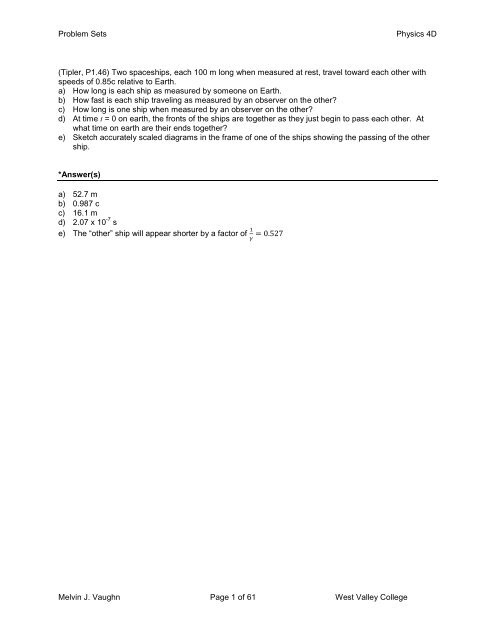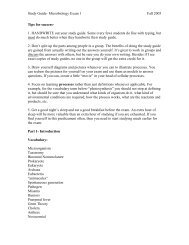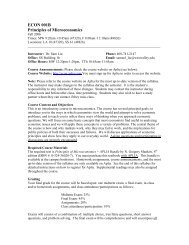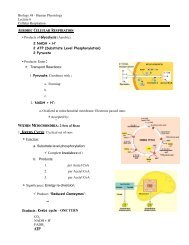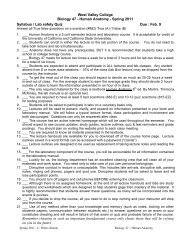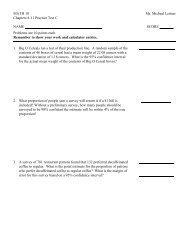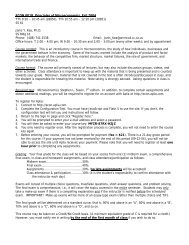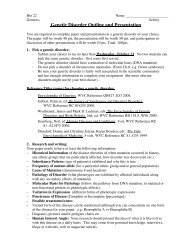Answers to Selected Problems - West Valley College
Answers to Selected Problems - West Valley College
Answers to Selected Problems - West Valley College
You also want an ePaper? Increase the reach of your titles
YUMPU automatically turns print PDFs into web optimized ePapers that Google loves.
Problem Sets Physics 4D<br />
(Tipler, P1.46) Two spaceships, each 100 m long when measured at rest, travel <strong>to</strong>ward each other with<br />
speeds of 0.85c relative <strong>to</strong> Earth.<br />
a) How long is each ship as measured by someone on Earth.<br />
b) How fast is each ship traveling as measured by an observer on the other?<br />
c) How long is one ship when measured by an observer on the other?<br />
d) At time t = 0 on earth, the fronts of the ships are <strong>to</strong>gether as they just begin <strong>to</strong> pass each other. At<br />
what time on earth are their ends <strong>to</strong>gether?<br />
e) Sketch accurately scaled diagrams in the frame of one of the ships showing the passing of the other<br />
ship.<br />
*Answer(s)<br />
a) 52.7 m<br />
b) 0.987 c<br />
c) 16.1 m<br />
d) 2.07 x 10 -7 s<br />
e) The “other” ship will appear shorter by a fac<strong>to</strong>r of<br />
Melvin J. Vaughn Page 1 of 61 <strong>West</strong> <strong>Valley</strong> <strong>College</strong>
Problem Sets Physics 4D<br />
The Captain of the Federation starship Enterprise observes two pho<strong>to</strong>n <strong>to</strong>rpedoes explode at two points<br />
exactly 1500 meters apart. The first explosion occurs at (x1, y1, z1, t1) = (0, 0, 0, 0) and the second at (x2,<br />
y2, z2, t2) = (1500 m, 0, 0, 0).<br />
a) How far apart are these two events according <strong>to</strong> a Klingon battlecruiser moving along the +x axis at<br />
.800c relative <strong>to</strong> Enterprise?<br />
b) Are the events simultaneous <strong>to</strong> the Klingons? If not, which event occurred first and what is their time<br />
difference?<br />
Answer(s)<br />
Melvin J. Vaughn Page 2 of 61 <strong>West</strong> <strong>Valley</strong> <strong>College</strong>
Problem Sets Physics 4D<br />
c) Ann observes two light pulses <strong>to</strong> be emitted from the same location, but separated in time by 3.00 μs.<br />
Bill sees the emission of the same two pulses separated in time by 9.00 μs.<br />
a) How fast is Bill moving relative <strong>to</strong> Ann?<br />
b) According <strong>to</strong> Bill, what is the separation in space of the two pulses?<br />
Answer(s)<br />
Melvin J. Vaughn Page 3 of 61 <strong>West</strong> <strong>Valley</strong> <strong>College</strong>
Problem Sets Physics 4D<br />
Suppose our Sun is about <strong>to</strong> explode. In an effort <strong>to</strong> escape, we depart in a spaceship at v = 0.80c and<br />
head <strong>to</strong>ward the star Tau Ceti, 12 light years away (in Earth’s reference frame). When we reach the<br />
midpoint of our journey from Earth, we see our Sun explode and, unfortunately, at the same instant we<br />
see Tau Ceti explode as well.<br />
a) In the spaceship’s frame of reference, should we conclude that the two explosions occurred<br />
simultaneously? If not, which occurred first?<br />
b) In a frame of reference in which the Sun and Tau Ceti are at rest, did they explode simultaneously? If<br />
not, which exploded first?<br />
Answer(s)<br />
a) Simultaneous.<br />
b) The Sun exploded first, 9.6 yrs before Tau Ceti.<br />
Melvin J. Vaughn Page 4 of 61 <strong>West</strong> <strong>Valley</strong> <strong>College</strong>
Problem Sets Physics 4D<br />
(Tipler, P1.57) Two observers agree <strong>to</strong> test time dilation. They use identical clocks and one observer in<br />
frame S’ moves with speed v = 0.6c relative <strong>to</strong> the other observer in frame S. When their origins coincide,<br />
they start their clocks. They agree <strong>to</strong> send a signal when their clocks read 60 min and <strong>to</strong> send a<br />
confirmation signal when each receives the other’s signal.<br />
a) When does the observer in S receive the first signal from the observer in S’? When does she receive<br />
the confirmation signal?<br />
b) Make a table showing the times in S when <strong>to</strong>e observer sent the first signal, received the first signal,<br />
and received the confirmation signal. How does this table compare with one constructed by the<br />
observer in S’?<br />
*Answer(s)<br />
a) The <strong>to</strong>tal time according <strong>to</strong> S: treceived = 120 minutes<br />
b) The <strong>to</strong>tal time for the confirmation signal: tconfirmation = 240 minutes<br />
c)<br />
S S’<br />
tsent 60 min. 60 min.<br />
treceived 120 min. 120 min.<br />
tconfirmation 240 min. 240 min.<br />
Melvin J. Vaughn Page 5 of 61 <strong>West</strong> <strong>Valley</strong> <strong>College</strong>
Problem Sets Physics 4D<br />
A very fast pole vaulter lives in the country. One day, while practicing, he notices a 10 m long barn with<br />
the doors open at both ends. He decides <strong>to</strong> run through the barn a 0.866 c while carrying his 16 m long<br />
pole. The farmer, who sees him coming, says, “Aha! This guy’s pole is length contracted. There will be<br />
a short interval of time when the pole is entirely inside the barn. If I’m quick, I can simultaneously close<br />
both barn doors while the pole vaulter and his pole are inside.” The pole vaulter, who sees the farmer<br />
beside the barn, thinks <strong>to</strong> himself, “That farmer is crazy. The barn is length contracted shorter than my<br />
pole. My 16 m long pole cannot fit in<strong>to</strong> that short barn. If the farmer closes both doors just as the tip of<br />
my pole reaches the back door, the front door will break off the end of my pole.”<br />
So, the farmer bets the pole vaulter that he can close both doors while the pole is in the barn. As the<br />
conditions of the bet, the farmer and vaulter agree that:<br />
When the farmer sees the front of the pole reach the back door, the farmer will open the back door.<br />
When the farmer sees the rear of the pole pass through the front door, the farmer will close both<br />
doors.<br />
Can the farmer close the doors without breaking the pole?<br />
Show that, when properly analyzed, the farmer and the pole vaulter agree on the outcome. Your analysis<br />
should contain both quantitative calculations and a written explanation.<br />
Furthermore, this analysis must contain a thorough discussion of each event (the closing of the front door,<br />
the closing of the rear door, and the opening of the rear door). For example: Were the events<br />
simultaneous <strong>to</strong> each observer? If not, when and where did each event occur? How are these events<br />
represented by a spacetime diagram?<br />
Answer(s)<br />
In the farmer’s reference frame:<br />
1) At t = 0 s, both doors are closed<br />
2) At t = +7.7 ns the back door is opened<br />
In the pole vaulter’s reference frame:<br />
1) At t = -57 ns the back door is cloded<br />
2) At t = 0 42 ns the back door is opened<br />
3) At t = 0 s the front door is closed.<br />
Since, in the pole vaulter’s reference frame, the back door is closed, then opened, followed by the fro<br />
door being opened, there is no paradox because there is no time at which the doors are closed at the<br />
same time.<br />
There is no paradox in the farmer’s reference frame, because there is a time at which the pole completely<br />
fits within the barn, so . . . they BOTH WIN the bet!!<br />
Melvin J. Vaughn Page 6 of 61 <strong>West</strong> <strong>Valley</strong> <strong>College</strong>
Problem Sets Physics 4D<br />
Show the relativity of time by proving the time dilation equation for an observer moving at velocity v<br />
relative <strong>to</strong> a light clock (as presented during lecture).<br />
Answer(s)<br />
t Melvin J. Vaughn Page 7 of 61 <strong>West</strong> <strong>Valley</strong> <strong>College</strong><br />
t<br />
1<br />
0<br />
2<br />
v<br />
2<br />
c
Problem Sets Physics 4D<br />
1) If you were traveling with respect <strong>to</strong> the stars at a speed close <strong>to</strong> the speed of light, you could detect it<br />
because<br />
a) your mass would increase<br />
b) your heart would slow down<br />
c) you would shrink<br />
d) . . . all of the above<br />
e) you could never tell your speed by changes in you<br />
2) Astronomers on Earth measure a distant star <strong>to</strong> be eight light years away, and when they decide <strong>to</strong><br />
send an astronaut <strong>to</strong> explore it at nearly the speed of light, the astronaut has only aged two years,<br />
while several years pass on earth. When they discuss the time difference, the astronaut says that it<br />
is because of time dilation, yet the astronomers say it must be due <strong>to</strong> length contraction. Who is<br />
right?<br />
a) the astronomers<br />
b) the astronaut<br />
c) neither, the reason lies in relativistic momentum<br />
d) they are both correct, it’s the same phenomenon<br />
Melvin J. Vaughn Page 8 of 61 <strong>West</strong> <strong>Valley</strong> <strong>College</strong>
Problem Sets Physics 4D<br />
Sam leaves Venus in a spaceship headed <strong>to</strong> Mars and passes Sally, who is on Earth, with a relative<br />
speed of 0.5c.<br />
a) Each measures the Venus-Mars voyage time. Who measures a proper time: Sam, Sally, or neither?<br />
b) On the way, Sam sends a pulse of light <strong>to</strong> mars. Each measures the travel time of the pulse. Who<br />
measures a proper time?<br />
Answer(s)<br />
a) Sam<br />
b) neither<br />
Melvin J. Vaughn Page 9 of 61 <strong>West</strong> <strong>Valley</strong> <strong>College</strong>
Problem Sets Physics 4D<br />
An unstable high-energy particle enters a detec<strong>to</strong>r and leaves a track of length 1.05 mm before it decays.<br />
Its speed relative <strong>to</strong> the detec<strong>to</strong>r was 0.992c. What is its proper lifetime? That is, how long would the<br />
particle have lasted before decay had it been at rest with respect <strong>to</strong> the detec<strong>to</strong>r?<br />
Answer(s)<br />
Melvin J. Vaughn Page 10 of 61 <strong>West</strong> <strong>Valley</strong> <strong>College</strong>
Problem Sets Physics 4D<br />
The premise of the Planet of the Apes movies and book is that hibernating astronauts travel far in<strong>to</strong><br />
Earth’s future, <strong>to</strong> a time when human civilization has been replaced by an ape civilization. Considering<br />
only special relativity, determine how far in<strong>to</strong> Earth’s future the astronauts would travel if they slept for<br />
120 y while traveling relative <strong>to</strong> Earth with a speed of 0.9990c, first outward from earth and then back<br />
again.<br />
Answer(s)<br />
Melvin J. Vaughn Page 11 of 61 <strong>West</strong> <strong>Valley</strong> <strong>College</strong>
Problem Sets Physics 4D<br />
The center of our Milky Way galaxy is about 23000 ly away.<br />
a) To eight significant figures, at what fraction of the speed of light would you need <strong>to</strong> travel exactly<br />
23000 ly (measured in the Galaxy frame) in exactly 30 y (measured in your frame)?<br />
b) Measured in your frame and in light-years, what length of the Galaxy would pass by you during the<br />
trip?<br />
Answer(s)<br />
Melvin J. Vaughn Page 12 of 61 <strong>West</strong> <strong>Valley</strong> <strong>College</strong>
Problem Sets Physics 4D<br />
The proper length of one spaceship is three times that of another. The two spaceships are traveling in<br />
the same direction and, while both are passing overhead, an Earth observer measures the two<br />
spaceships <strong>to</strong> have the same length. If the slower spaceship is moving with a speed of 0.35c, determine<br />
the speed of the faster spaceship.<br />
Answer(s)<br />
Melvin J. Vaughn Page 13 of 61 <strong>West</strong> <strong>Valley</strong> <strong>College</strong>
Problem Sets Physics 4D<br />
Two powerless rockets are on a collision course. Rocket A is moving at 0.800c relative <strong>to</strong> Ann, an Earth<br />
observer. Rocket B is moving at -0.600 c relative <strong>to</strong> Ann. The two rockets are initially 2.52 x 10 12 m apart<br />
and both are 50.0 m in length, as measured by Ann.<br />
a) What are their respective proper lengths?<br />
b) What is the length of each rocket as measured by an observer in the other rocket?<br />
c) According <strong>to</strong> Ann, how long before the rockets collide?<br />
d) According <strong>to</strong> rocket A, how long before they collide?<br />
e) According <strong>to</strong> rocket B, how long before they collide?<br />
f) If both crews are capable of <strong>to</strong>tal evacuation within 90 minutes (their own time), will there be any<br />
casualties?<br />
*Answer(s)<br />
a) ΔL0A = 83.3 m<br />
b) ΔL0B = 62.5 m<br />
c) ΔtAnn = 6000 s = 100 min.<br />
d) ΔtA = 5.33 x 103 s = 88.8 min.<br />
e) ΔtB = 7.10 x 103 s = 118 min.<br />
f) Since it takes 90 minutes for each crew <strong>to</strong> abandon its ship, the crew in rocketship A will be able <strong>to</strong><br />
escape in time, but the crew in rocketship B will not escape.<br />
Melvin J. Vaughn Page 14 of 61 <strong>West</strong> <strong>Valley</strong> <strong>College</strong>
Problem Sets Physics 4D<br />
Event 1 takes place at the origin of reference frame S, while Event 2 takes place at an x-coordinate of<br />
3.00 ly in reference frame S. What is the minimum separation in time for Event 1 <strong>to</strong> be causally affected<br />
by Event 2? Analyze by<br />
a) drawing a spacetime diagram<br />
b) evaluating the spacetime interval.<br />
Answer(s)<br />
Melvin J. Vaughn Page 15 of 61 <strong>West</strong> <strong>Valley</strong> <strong>College</strong>
Problem Sets Physics 4D<br />
2) (Tipler, P1.17) Consider a clock at rest at the origin of the labora<strong>to</strong>ry frame.<br />
a) Draw a spacetime diagram that illustrates that this clock ticks slow when observed from the<br />
reference frame of a rocket moving with respect <strong>to</strong> the labora<strong>to</strong>ry at v = 0.800c.<br />
b) When 10.0 s have elapsed on the rocket clock, how many have ticked by on the lab clock?<br />
Answer(s)<br />
Melvin J. Vaughn Page 16 of 61 <strong>West</strong> <strong>Valley</strong> <strong>College</strong>
Problem Sets Physics 4D<br />
(Tipler, P1.42) In frame S, event B occurs 2.00 μs after event A and at Δx = 1.50 km from event A.<br />
a) How fast must an observer be moving along the +x axis so that events A and B occur simultaneously?<br />
b) Is it possible for event B <strong>to</strong> precede event A for some observer?<br />
c) Draw a spacetime diagram that illustrates your answers <strong>to</strong> a) and b).<br />
d) Compute the spacetime interval and proper distance between the events.<br />
*Answer(s)<br />
a) v = 1.20 x 10 8 m/s = 0.400 c<br />
b) Yes, it is possible for event B <strong>to</strong> precede event A if v > 0.400 c for some observer.<br />
c)<br />
d) Δs = 1.37 x 10 3 m; Δx = 1.37 x 10 3 m<br />
Melvin J. Vaughn Page 17 of 61 <strong>West</strong> <strong>Valley</strong> <strong>College</strong>
Problem Sets Physics 4D<br />
(Tipler, P1.52) An observer in frame S standing at the origin observes two flashes of colored light<br />
separated spatially by Δx = 2400 m. A blue flash occurs first, followed by a red flash 5.00 μs later. An<br />
observer in S’ moving along the x axis at speed v relative <strong>to</strong> S also observes the flashes 5.00 μs apart<br />
and with a separation of 2400 m, but the red flash is observed first. Find the magnitude and direction of v.<br />
Answer(s)<br />
Melvin J. Vaughn Page 18 of 61 <strong>West</strong> <strong>Valley</strong> <strong>College</strong>
Problem Sets Physics 4D<br />
While onboard a starship, you intercept signals from four shuttle craft that are moving either directly<br />
<strong>to</strong>ward or directly away from you. The signals have the same proper frequency f0. The speed and<br />
direction (both relative <strong>to</strong> you) of the shuttle craft are<br />
a) 0.3c <strong>to</strong>ward,<br />
b) 0.6c <strong>to</strong>ward,<br />
c) 0.3c away, and<br />
d) 0.6c away.<br />
Rank the shuttle craft according <strong>to</strong> the frequency you receive, greatest first.<br />
Answer(s)<br />
Melvin J. Vaughn Page 19 of 61 <strong>West</strong> <strong>Valley</strong> <strong>College</strong>
Problem Sets Physics 4D<br />
You wake up at night in your berth on a train <strong>to</strong> find yourself being “pulled” <strong>to</strong> one side of the train. You<br />
naturally assume that the train is rounding a curve, but you are puzzled that you don’t hear any sounds of<br />
motion. Offer another possible explanation that involves only gravity, not acceleration of your frame of<br />
reference.<br />
Answer(s)<br />
Melvin J. Vaughn Page 20 of 61 <strong>West</strong> <strong>Valley</strong> <strong>College</strong>
Problem Sets Physics 4D<br />
We readily note the bending of light by reflection and refraction, but why are we not aware of the bending<br />
of light by gravity?<br />
Answer(s)<br />
Melvin J. Vaughn Page 21 of 61 <strong>West</strong> <strong>Valley</strong> <strong>College</strong>
Problem Sets Physics 4D<br />
Why do we say that light travels in straight lines? Is it strictly accurate <strong>to</strong> say that a laser beam provides a<br />
perfectly straight line for purposes of surveying? Explain.<br />
Answer(s)<br />
Melvin J. Vaughn Page 22 of 61 <strong>West</strong> <strong>Valley</strong> <strong>College</strong>
Problem Sets Physics 4D<br />
Would we notice the slowing down or speeding up of a clock if we carried it <strong>to</strong> the bot<strong>to</strong>m of a very deep<br />
well?<br />
Answer(s)<br />
We wouldn’t notice it at all. However, an observer at the surface would observe that the clock carried <strong>to</strong><br />
the bot<strong>to</strong>m of the well runs slightly faster, since the gravitational field is slightly weaker there.<br />
Melvin J. Vaughn Page 23 of 61 <strong>West</strong> <strong>Valley</strong> <strong>College</strong>
Problem Sets Physics 4D<br />
The celebrated equation E = mc 2 or m = E/c 2 (C is the speed of light) tells us how much mass loss, m, must<br />
be suffered by a nuclear reac<strong>to</strong>r in order <strong>to</strong> generate a given amount of energy, E. Which of the following<br />
statements is correct? Why or why not?<br />
a) The same equation E = mc 2 or m = E/c 2 , also tells us how much mass loss, m, must be suffered by a<br />
flashlight battery when the flashlight puts out a given amount of energy, E.<br />
b) The equation E = mc 2 applies <strong>to</strong> nuclear energy in a reac<strong>to</strong>r, but not <strong>to</strong> chemical energy in a battery.<br />
Answer(s)<br />
Melvin J. Vaughn Page 24 of 61 <strong>West</strong> <strong>Valley</strong> <strong>College</strong>
Problem Sets Physics 4D<br />
Armed with highly sensitive detection equipment, you are in the front of a railroad car that is accelerating<br />
forward. Your friend at the rear of the car shines green light <strong>to</strong>ward you.<br />
a) Do you find the light <strong>to</strong> be red-shifted (lower frequency and energy), blue-shifted (higher frequency<br />
and energy), or neither?<br />
b) Explain by using the principle of equivalence.<br />
*Answer(s)<br />
a) Since the train is accelerating away from the green light, the light will be red-shifted, indicating that it<br />
possesses lower frequency and energy relative <strong>to</strong> the observer in the front of the train.<br />
b) The Principle of Equivalence states that there is no distinction between a uniform gravitational field<br />
and a uniformly accelerating frame of reference. Therefore, the uniform acceleration of the train is<br />
indistinguishable of gravity, therefore, causing the green light <strong>to</strong> “lose energy” as it follows the<br />
“curvature” in the train’s spacetime.<br />
Melvin J. Vaughn Page 25 of 61 <strong>West</strong> <strong>Valley</strong> <strong>College</strong>
Problem Sets Physics 4D<br />
A spaceship, moving away from Earth at a speed of 0.900c, reports back by transmitting at a frequency<br />
(measured in the spaceship frame) of 100 MHz. To what frequency must Earth receivers be tuned <strong>to</strong><br />
receive the report?<br />
*Answer(s)<br />
22.9 MHz<br />
Melvin J. Vaughn Page 26 of 61 <strong>West</strong> <strong>Valley</strong> <strong>College</strong>
Problem Sets Physics 4D<br />
A spaceship is moving away from Earth at speed 0.20c. A source on the rear of the ship emits light at<br />
wavelength 450 nm according <strong>to</strong> someone on the ship. What<br />
a) wavelength and<br />
b) color (blue, green, yellow, or red) are detected by someone on Earth watching the ship?<br />
*Answer(s)<br />
a) 550 nm;<br />
b) yellow<br />
Melvin J. Vaughn Page 27 of 61 <strong>West</strong> <strong>Valley</strong> <strong>College</strong>
Problem Sets Physics 4D<br />
The mass of an electron is 9.10938188 x 10 -31 kg. To six significant figures, find the speed for an electron<br />
with kinetic energy K = 100.000 MeV.<br />
Answer(s)<br />
0.99987c<br />
Melvin J. Vaughn Page 28 of 61 <strong>West</strong> <strong>Valley</strong> <strong>College</strong>
Problem Sets Physics 4D<br />
A 5.00 grain aspirin tablet has a mass of 320. mg. For how many kilometers would the energy equivalent<br />
of this mass power an au<strong>to</strong>mobile? Assume 12.75 km/L and a heat of combustion of 3.65 J/L for the<br />
gasoline used in the au<strong>to</strong>mobile.<br />
Answer(s)<br />
1.01 x 10 14 km<br />
Melvin J. Vaughn Page 29 of 61 <strong>West</strong> <strong>Valley</strong> <strong>College</strong>
Problem Sets Physics 4D<br />
Answer the following:<br />
a) How much energy is released in the explosion of a fission bomb containing 3.0 kg of fissionable<br />
material? Assume that 0.10% of the mass is converted <strong>to</strong> energy.<br />
b) What mass of TNT would have <strong>to</strong> explode <strong>to</strong> provide this same energy release? Assume that each<br />
mole of TNT liberates 3.4 x 10 6 J of energy on exploding. The molecular mass of TNT is 0.227<br />
kg/mol.<br />
c) For the same mass of explosive, what is the ratio of the energy released in a nuclear explosion <strong>to</strong> that<br />
released in a TNT explosion?<br />
Answer(s)<br />
Melvin J. Vaughn Page 30 of 61 <strong>West</strong> <strong>Valley</strong> <strong>College</strong>
Problem Sets Physics 4D<br />
How much work must be done <strong>to</strong> increase the speed of an electron<br />
a) from 0.18c <strong>to</strong> 0.19c?<br />
b) 0.98c <strong>to</strong> 0.99c?<br />
Note: The speed increase is 0.01c in both cases.<br />
Answer(s)<br />
Melvin J. Vaughn Page 31 of 61 <strong>West</strong> <strong>Valley</strong> <strong>College</strong>
Problem Sets Physics 4D<br />
What must be the momentum of a particle of rest mass m0 so that the <strong>to</strong>tal energy of the particle is 3.00<br />
times its rest energy?<br />
Answer(s)<br />
Melvin J. Vaughn Page 32 of 61 <strong>West</strong> <strong>Valley</strong> <strong>College</strong>
Problem Sets Physics 4D<br />
Left over from the big-bang at the beginning of our universe, tiny black holes might still wander through<br />
the universe. If one with a mass of 1.00 x 10 11 kg (and a radius of only 1.00 x 10 -16 m) reached Earth,<br />
a) at what distance above your head would its gravitational pull on you match that of Earth’s (Use<br />
New<strong>to</strong>n’s Universal law of gravitation)?<br />
b) At what distance would your head be sucked in<strong>to</strong> the black hole, with no possibility of escape?<br />
Answer(s)<br />
Melvin J. Vaughn Page 33 of 61 <strong>West</strong> <strong>Valley</strong> <strong>College</strong>
Problem Sets Physics 4D<br />
In a Millikan experiment the distance of rise or fall of a droplet is 0.600 cm and the average time of fall<br />
when E = 0 is 21.0 s. The observed successive rise times when the electric field is on are 46.0 s, 15.5 s,<br />
28.1 s, 12.9 s, 45.3 s, and 20.0 s.<br />
Using the derivation done in class:<br />
q<br />
mg v v <br />
T E<br />
<br />
E vT<br />
<br />
a) Prove that charge is quantized. (Hint: charge is quantized if ratios of charge are ratios of small whole<br />
numbers: e.g. q1/q2 = 2/5, q2/q3 = 5/7, etc.)<br />
b) Calculate the successive charges on each drop, and, from these results, determine the fundamental<br />
electric charge. Assume a plate separation of 1.60 cm, a potential difference of 4550 V for the<br />
parallel-plate capaci<strong>to</strong>r, and the mass for an oil drop of 1.67 x 10 -14 kg.<br />
Hint: In Millikan’s time, e was known <strong>to</strong> be between 1.50 x 10 -19 C and 2.00 x 10 -19 C. Dividing q1 through<br />
q6 by each of these values gives the range of integral charges on each drop. For example, if q1 = 8.39 x<br />
10 -19 C, then the range for q1 is 8.39 / 1.5 = 5.6 and 8.39 / 2.0 = 4.2 multiples of electric charge e. Since 5<br />
is an integer between 4.2 and 5.6. we can conclude that q1 = 5e, or e = q1/5. In like manner, determining e<br />
for each charge, then averaging them, will generate the value of the electronic charge as determined in<br />
Millikan’s day <strong>to</strong> be e = 1.69 x 10 -19 C.<br />
Answer(s): (see Excel File, “p4d_charge_quantization_computation.xls” for calculations)<br />
a)<br />
q1/q2 = 5/8; q1/q3 = 5/6; q1/q4 = 5/9; q1/q5 = 1; q1/q6 = 5/7<br />
q2/q3 = 4/3; q2/q4 = 8/9; q2/q5 = 8/5; q2/q6 = 8/7<br />
q3/q4 = 2/3; q3/q5 = 6/5; q3/q6 = 6/7<br />
q4/q5 = 9/5; q4/q6 = 9/7<br />
q5/q6 = 5/7<br />
n1 = 5<br />
n2 = 8<br />
n3 = 6<br />
n4 = 9<br />
n5 = 5<br />
n6 = 7<br />
b)<br />
q1 = n1∙e = 8.38 x 10 -19 C<br />
q2 = n2∙e =1.36 x 10 -18 C<br />
q3 = n3∙e =1.01 x 10 -18 C<br />
q4 = n4∙e =1.51 x 10 -18 C<br />
q5 = n5∙e =8.42 x 10 -19 C<br />
q6 = n6∙e =1.18 x 10 -18 C<br />
eavg = 1.68 x 10 -19 C<br />
Melvin J. Vaughn Page 34 of 61 <strong>West</strong> <strong>Valley</strong> <strong>College</strong>
Problem Sets Physics 4D<br />
1) In a pho<strong>to</strong>electric effect experiment, the intensity of the light is increased. As a result:<br />
a) There are more pho<strong>to</strong>electrons.<br />
b) The pho<strong>to</strong>electrons are faster.<br />
c) Both a and b.<br />
d) Neither a nor b.<br />
Explain your choice.<br />
Intensity of light is directly proportional <strong>to</strong> the number of pho<strong>to</strong>ns. A more intense light delivers a<br />
larger number of pho<strong>to</strong>ns <strong>to</strong> the surface, thereby ejecting a larger number of electrons, increasing the<br />
current.<br />
2) In a pho<strong>to</strong>electric effect experiment, the frequency of the light is increased. As a result:<br />
a) There are more pho<strong>to</strong>electrons.<br />
b) The pho<strong>to</strong>electrons are faster.<br />
c) Both a and b.<br />
d) Neither a nor b.<br />
Explain your choice.<br />
The maximum kinetic energy of electrons is directly proportional <strong>to</strong> the frequency of light, so, the<br />
higher the frequency the faster the pho<strong>to</strong>electrons.<br />
Melvin J. Vaughn Page 35 of 61 <strong>West</strong> <strong>Valley</strong> <strong>College</strong>
Problem Sets Physics 4D<br />
Metal 1 has a larger work function than metal 2. Both are illuminated with the same short wavelength<br />
ultraviolet light. Do pho<strong>to</strong>electrons from metal 1 have a higher speed, a lower speed, or the same speed<br />
as pho<strong>to</strong>electrons from metal 2? Explain.<br />
Answer(s)<br />
Since electrons in metal 1 has a larger work function than in metal 2, they require more of the pho<strong>to</strong>n’s<br />
energy <strong>to</strong> be liberated from the material. Therefore, they will have a lower speed than the pho<strong>to</strong>electrons<br />
emitted from metal 2.<br />
Melvin J. Vaughn Page 36 of 61 <strong>West</strong> <strong>Valley</strong> <strong>College</strong>
Problem Sets Physics 4D<br />
The figure shows a typical current vs. potential difference graph for a pho<strong>to</strong>electric effect experiment.<br />
Directly on the figure, draw and label graphs for the following three situations (assuming that no other<br />
parameters of the experiment are changed):<br />
a) The light intensity is increased.<br />
b) The light frequency is increased.<br />
c) The cathode work function is increased.<br />
Answer(s)<br />
a) Maximum current increases;<br />
b) –Vs<strong>to</strong>p decreases;<br />
c) –Vs<strong>to</strong>p increases.<br />
Melvin J. Vaughn Page 37 of 61 <strong>West</strong> <strong>Valley</strong> <strong>College</strong><br />
ΔV
Problem Sets Physics 4D<br />
The figure shows a typical current vs. frequency<br />
graph for a pho<strong>to</strong>electric effect experiment. On the<br />
figure, draw and label graphs for the following three<br />
situations (assuming that no other parameters of<br />
the experiment are changed):<br />
a) The light intensity is increased.<br />
b) The anode-cathode potential difference is<br />
increased.<br />
c) The cathode work function is increased.<br />
Answer(s)<br />
a) Current increases, f0 remains the same;<br />
b) Maximum current increases, f0 remains the same; c) f0 increases<br />
Melvin J. Vaughn Page 38 of 61 <strong>West</strong> <strong>Valley</strong> <strong>College</strong>
Problem Sets Physics 4D<br />
The figure shows a typical s<strong>to</strong>pping potential vs.<br />
frequency graph for a pho<strong>to</strong>electric effect<br />
experiment. On the figure, draw and label graphs<br />
for the following two situations (assuming that no<br />
other parameters of the experiment are changed):<br />
a) The light intensity is increased.<br />
b) The cathode work function is increased.<br />
Answer(s)<br />
a) remains the same;<br />
b) f0 increases, graph shifts <strong>to</strong> the right.<br />
Melvin J. Vaughn Page 39 of 61 <strong>West</strong> <strong>Valley</strong> <strong>College</strong>
Problem Sets Physics 4D<br />
When Cesium metal is illuminated with light of wavelength 300 nm, the pho<strong>to</strong>electrons emitted have a<br />
maximum kinetic energy of 2.23 eV. Find<br />
a) the work function of cesium, and<br />
b) the s<strong>to</strong>pping potential if the incident light has a wavelength of 400 nm.<br />
Answer(s)<br />
Melvin J. Vaughn Page 40 of 61 <strong>West</strong> <strong>Valley</strong> <strong>College</strong>
Problem Sets Physics 4D<br />
An FM radio station of frequency 107.7 MHz puts out a signal of 50,000 W. How many pho<strong>to</strong>ns/s are<br />
emitted?<br />
Answer(s)<br />
Melvin J. Vaughn Page 41 of 61 <strong>West</strong> <strong>Valley</strong> <strong>College</strong>
Problem Sets Physics 4D<br />
How many pho<strong>to</strong>ns/s are contained in a beam of electromagnetic radiation of <strong>to</strong>tal power 150W if the<br />
source is an<br />
a) AM radio station of 1100 kHz,<br />
b) 8.0 nm x-rays, and<br />
c) 4.0 MeV gamma rays?<br />
Answer(s)<br />
a) 2.06 x 10 29<br />
b) 6.05 x 10 18<br />
c) 2.34 x 10 14<br />
Melvin J. Vaughn Page 42 of 61 <strong>West</strong> <strong>Valley</strong> <strong>College</strong>
Problem Sets Physics 4D<br />
What is the maximum wavelength of incident light that can produce pho<strong>to</strong>electrons from silver (φ = 4.64<br />
eV)? What will be the maximum kinetic energy of the pho<strong>to</strong>electrons if the wavelength is halved?<br />
Answer(s)<br />
a) λ = 267.2 nm;<br />
b) K = 4.64 eV<br />
Melvin J. Vaughn Page 43 of 61 <strong>West</strong> <strong>Valley</strong> <strong>College</strong>
Problem Sets Physics 4D<br />
In a pho<strong>to</strong>electric experiment it is found that a s<strong>to</strong>pping potential of 1.00 V is needed <strong>to</strong> s<strong>to</strong>p all the<br />
electrons when incident light of wavelength 260 nm is used and 2.30 V is needed for light of wavelength<br />
207 nm. From these data determine Planck’s constant and the work function of the metal.<br />
Answer(s)<br />
h = 4.40 x 10 -15 eV∙s ; φ = 4.1 eV<br />
Melvin J. Vaughn Page 44 of 61 <strong>West</strong> <strong>Valley</strong> <strong>College</strong>
Problem Sets Physics 4D<br />
A pho<strong>to</strong>n having 40 keV scatters from a free electron at rest. What is the maximum energy that the<br />
electron can obtain?<br />
Answer(s)<br />
5.41 eV<br />
Melvin J. Vaughn Page 45 of 61 <strong>West</strong> <strong>Valley</strong> <strong>College</strong>
Problem Sets Physics 4D<br />
A pho<strong>to</strong>n of wavelength 2.0 nm Comp<strong>to</strong>n-scatters from an electron at an angle of 90º. What is the<br />
modified wavelength and the percentage change Δλ/λ?<br />
Answer(s)<br />
2.00243 nm; Δλ/λ 0.122%<br />
Melvin J. Vaughn Page 46 of 61 <strong>West</strong> <strong>Valley</strong> <strong>College</strong>
Problem Sets Physics 4D<br />
(P3.15: Thorn<strong>to</strong>n and Rex, 3 rd Ed.) The Spitzer Space Telescope was launched in 2003 <strong>to</strong> detect infrared<br />
radiation. Suppose that a particle detec<strong>to</strong>r on the telescope is sensitive over part of the near infrared<br />
region of wavelengths 980 - 1920 nm. Astronomers want <strong>to</strong> detect the radiation being emitted from a red<br />
giant star and decide <strong>to</strong> concentrate on wavelengths from the Paschen series of the line spectra of the<br />
hydrogen a<strong>to</strong>m.<br />
a) What are the known wavelengths in this region? Calculate these values!<br />
b) The detec<strong>to</strong>r measures wavelengths of 1334.5, 1138.9, and 1046.1 nm believed <strong>to</strong> be from the<br />
Paschen series. Why are these wavelengths different than those found in part a)?<br />
c) How fast is the star moving with respect <strong>to</strong> us? (Hint: Doppler shift)<br />
Answer(s)<br />
a)<br />
k = 4, λ = 1875.63 nm;<br />
k = 5, λ = 1282.17 nm;<br />
k = 6, λ = 1094.12 nm;<br />
k = 7, λ = 1005.22 nm;<br />
k = 8, λ = 954.86 nm<br />
b) The observed spectral lines have been Doppler redshifted.<br />
c) 1.20 x 10 7 m/s<br />
Melvin J. Vaughn Page 47 of 61 <strong>West</strong> <strong>Valley</strong> <strong>College</strong>
Problem Sets Physics 4D<br />
A particle is known <strong>to</strong> be in a certain interval on the x-axis. A function dependent upon the particle’s<br />
position is given as:<br />
0,<br />
x 0<br />
f( x)<br />
<br />
1,<br />
0 x <br />
a) Plot this function.<br />
b) Find the Fourier Series of this function on the given interval.<br />
c) Graph the sum of the first seven terms of this function on the same graph used for part a).<br />
Answer(s)<br />
b)<br />
<br />
n<br />
1 1 1 1<br />
<br />
f ( x) <br />
sin nx <br />
2 n1<br />
n <br />
<br />
Melvin J. Vaughn Page 48 of 61 <strong>West</strong> <strong>Valley</strong> <strong>College</strong>
Problem Sets Physics 4D<br />
Determine the value of the coefficient A if every probable state of a particle is described by the following<br />
wave function:<br />
*Answer(s)<br />
A <br />
2 / 14<br />
1 3<br />
<br />
14 14<br />
x sin x Asin 2 x sin 5 x<br />
Melvin J. Vaughn Page 49 of 61 <strong>West</strong> <strong>Valley</strong> <strong>College</strong>
Problem Sets Physics 4D<br />
The Wave Equation for Poker.<br />
You decide <strong>to</strong> play your friends poker with five cards being dealt per hand. The following table gives the<br />
probability of being dealt a specific hand before the draw using 53-card deck - including Joker. Construct<br />
a wave function that represents your hand before you take a look. Assume each hand is mutually<br />
exclusive (orthogonal). For example, you can hold either a three-of-a-kind or one-pair, not both. (See<br />
next page)<br />
The probability of being dealt...<br />
(before the draw)<br />
Expressed in<br />
percent (%) is...<br />
The odds against it<br />
are...<br />
Number of<br />
possible<br />
combos<br />
5 ACES 0.00* 2,869,684 <strong>to</strong> 1 1<br />
STRAIGHT-FLUSH<br />
Royal Flush<br />
Other Straight Flush<br />
0.01<br />
0.00**<br />
0.01<br />
14,066 <strong>to</strong> 1<br />
119,569 <strong>to</strong> 1<br />
15,942 <strong>to</strong> 1<br />
FOUR-OF-A-KIND 0.03 3,465 <strong>to</strong> 1 828<br />
FULL HOUSE 0.15 656 <strong>to</strong> 1 4,368<br />
FLUSH 0.27 367 <strong>to</strong> 1 7,804<br />
STRAIGHT 0.71 139 <strong>to</strong> 1 20,532<br />
THREE-OF-A-KIND<br />
3 Aces<br />
Three-of-a-kind<br />
(Large: K's - 8's)<br />
Three-of-a-kind<br />
(Small: 7's - 2's)<br />
TWO-PAIR<br />
Aces-up<br />
K-up, Q-up, J-up<br />
Small Two-Pair<br />
(Tens-up and under)<br />
2.21<br />
0.37<br />
0.92<br />
Melvin J. Vaughn Page 50 of 61 <strong>West</strong> <strong>Valley</strong> <strong>College</strong><br />
0.92<br />
4.83<br />
1.10<br />
1.69<br />
2.03<br />
44.3 <strong>to</strong> 1<br />
271 <strong>to</strong> 1<br />
108 <strong>to</strong> 1<br />
108 <strong>to</strong> 1<br />
19.7 <strong>to</strong> 1<br />
89.6 <strong>to</strong> 1<br />
58.0 <strong>to</strong> 1<br />
48.2 <strong>to</strong> 1<br />
204<br />
24<br />
180<br />
63,360<br />
10,560<br />
26,400<br />
26,400<br />
138,600<br />
31,680<br />
48,600<br />
58,320<br />
ONE PAIR 42.34 1.36 <strong>to</strong> 1 1,215,024<br />
PAIR OF A,K,Q,J (Openers)<br />
Aces<br />
Kings<br />
Queens<br />
Jacks<br />
SHORTS<br />
Shorts<br />
(Large: 10's - 7's)<br />
Shorts<br />
(Small: 6's - 2's)<br />
14.19<br />
4.81<br />
3.13<br />
3.13<br />
3.13<br />
28.15<br />
12.51<br />
15.64<br />
6.05 <strong>to</strong> 1<br />
19.8 <strong>to</strong> 1<br />
31.0 <strong>to</strong> 1<br />
31.0 <strong>to</strong> 1<br />
31.0 <strong>to</strong> 1<br />
2.55 <strong>to</strong> 1<br />
6.99 <strong>to</strong> 1<br />
5.39 <strong>to</strong> 1<br />
407,184<br />
137,904<br />
89,760<br />
89,760<br />
89,760<br />
807,840<br />
359,040<br />
448,800
Problem Sets Physics 4D<br />
Answer(s)<br />
0.0000* 0.0001 0.0003 0.0015<br />
hand 5acesstraightflush 4ofakind<br />
fullhouse<br />
0.0027 0.0071 0.0221 0.0483<br />
flush straight 3ofakind 2pair<br />
0.4234 0.1419 <br />
0.2815<br />
1pair<br />
pairAKQJ shorts<br />
Melvin J. Vaughn Page 51 of 61 <strong>West</strong> <strong>Valley</strong> <strong>College</strong>
Problem Sets Physics 4D<br />
The purpose of the following exercise is <strong>to</strong> demonstrate that a particle’s wave group velocity is equal <strong>to</strong><br />
the particle’s velocity.<br />
A particle’s phase velocity does not have <strong>to</strong> equal <strong>to</strong> its particle velocity. In fact, show that a particle’s<br />
deBroglie wave velocity is equal <strong>to</strong> half its particle velocity:<br />
1<br />
v v<br />
2<br />
phase particle<br />
a) Show that the group velocity of a particle’s wave packet is equal <strong>to</strong> the derivative of its energy with<br />
respect <strong>to</strong> its relativistic momentum:<br />
v<br />
group<br />
dE<br />
<br />
dp<br />
b) Show that the group velocity of a particle’s wave packet is equal <strong>to</strong> its particle velocity:<br />
Answer(s)<br />
vgroup vparticle<br />
Melvin J. Vaughn Page 52 of 61 <strong>West</strong> <strong>Valley</strong> <strong>College</strong>
Problem Sets Physics 4D<br />
Two waves of equal amplitude are moving down a Slinky at different speeds are given by<br />
( x, t) Asin( k x <br />
t)<br />
1 1 1<br />
a) Write an expression for the resulting superimposed wave.<br />
( x, t) Asin( k x <br />
t)<br />
and 1 2 2<br />
Suppose A = 0.0030 m, k1 = 6.0 m -1 , k2 = 7.0 m -1 , ω1 = 300 s -1 , and ω2 = 250 s -1<br />
b) Graph the superimposed wave at time t = 0.<br />
c) What are the phase and group velocities of this wave?<br />
d) What is Δx between two adjacent zeros of Ψ? (Note: Δx tells us how spread out this wave packet is –<br />
it is the wave envelope.)<br />
e) What is ΔkΔx?<br />
Answer(s)<br />
Melvin J. Vaughn Page 53 of 61 <strong>West</strong> <strong>Valley</strong> <strong>College</strong>
Problem Sets Physics 4D<br />
A particle is known <strong>to</strong> be in a certain interval on the x-axis. A function dependent upon the particle’s<br />
position is given as:<br />
0,<br />
x 0<br />
f( x)<br />
<br />
1,<br />
0 x <br />
a) Plot this function.<br />
b) Find the Fourier Series of this function on the given interval.<br />
c) Graph the sum of the first seven terms of this function on the same graph used for part a).<br />
Answer(s)<br />
b)<br />
<br />
n<br />
1 1 1 1<br />
<br />
f ( x) <br />
sin nx <br />
2 n1<br />
n <br />
<br />
Melvin J. Vaughn Page 54 of 61 <strong>West</strong> <strong>Valley</strong> <strong>College</strong>
Problem Sets Physics 4D<br />
A thin solid barrier in the xy-plane has a 10 μm diameter circular hole. An electron traveling in the zdirection<br />
with vx = 0 m/s passes through the hole. Afterward, is vx still zero? If not, within what range is vx<br />
likely <strong>to</strong> be?<br />
Answer(s)<br />
Melvin J. Vaughn Page 55 of 61 <strong>West</strong> <strong>Valley</strong> <strong>College</strong>
Problem Sets Physics 4D<br />
Aliens visiting Earth are fascinated by baseball. They are so advanced that they have learned how <strong>to</strong><br />
vary <strong>to</strong> make sure that a pitcher cannot throw a strike with any confidence. Assume the width of the<br />
strike zone is 0.38 m, the speed of the baseball is 35 m/s, the mass of the baseball is 145 g, and the ball<br />
travels a distance of 18 m. What value of is required? (Hint: there are two uncertainties here: the width<br />
of the strike zone and the transverse momentum of the pitched ball.)<br />
*Answer(s)<br />
≥ 0.081 J∙s<br />
Melvin J. Vaughn Page 56 of 61 <strong>West</strong> <strong>Valley</strong> <strong>College</strong>
Problem Sets Physics 4D<br />
What is the wavelength of<br />
a) a pho<strong>to</strong>n with energy 1.00 eV,<br />
b) an electron with energy of 1.00 eV,<br />
c) a pho<strong>to</strong>n of energy 1.00 GeV, and<br />
d) an electron with energy 1.00 GeV?<br />
Answer(s)<br />
a) 1.24 µm;<br />
b) 1.22 nm;<br />
c) 1.24 fm;<br />
d) 1.24 fm<br />
Melvin J. Vaughn Page 57 of 61 <strong>West</strong> <strong>Valley</strong> <strong>College</strong>
Problem Sets Physics 4D<br />
A 5000 kg elephant is <strong>to</strong> move through a 1.00 m radius circular opening.<br />
a) How fast must it move in order <strong>to</strong> diffract through the opening?<br />
b) How fast must an electron move <strong>to</strong> diffract through the opening?<br />
If the opening is 1.00 nm in radius,<br />
c) how fast must the elephant move <strong>to</strong> diffract through it?<br />
d) how fast must the electron move <strong>to</strong> diffract through it?<br />
Answer(s)<br />
a) 6.63 x 10 -38 m/s;<br />
b) 3.64 x 10 -4 m/s;<br />
c) 6.63 x 10 -27 m/s;<br />
d) 3.64 x 10 5 m/s<br />
Melvin J. Vaughn Page 58 of 61 <strong>West</strong> <strong>Valley</strong> <strong>College</strong>
Problem Sets Physics 4D<br />
The highest achievable resolving power of a microscope is limited only by the wavelength used; that is,<br />
the smallest item that can be distinguished has dimensions about equal <strong>to</strong> the wavelength. Suppose one<br />
wishes <strong>to</strong> “see” inside an a<strong>to</strong>m. Assuming the a<strong>to</strong>m <strong>to</strong> have a diameter of 100 pm, this means that one<br />
must be able <strong>to</strong> resolve a width of, say, 10 pm.<br />
a) If an electron microscope is used, what minimum electron energy is required?<br />
b) If a light microscope is used, what minimum pho<strong>to</strong>n energy is required?<br />
c) Which microscope seems more practical? Why?<br />
Answer(s)<br />
a) 15 keV;<br />
b) 120 keV<br />
Melvin J. Vaughn Page 59 of 61 <strong>West</strong> <strong>Valley</strong> <strong>College</strong>
Problem Sets Physics 4D<br />
What is the position uncertainty, in nm, of an electron whose velocity is known <strong>to</strong> be between 3.48 x 10 5<br />
m/s and 3.58 x 10 5 m/s?<br />
Answer(s)<br />
5.79 nm<br />
Melvin J. Vaughn Page 60 of 61 <strong>West</strong> <strong>Valley</strong> <strong>College</strong>
Problem Sets Physics 4D<br />
Andrea, whose mass is 50 kg, think she’s sitting at rest in her 5.0 m long dorm room as she does her<br />
physics homework. Can Andrea be sure she’s at rest? If not, within what range is her velocity likely <strong>to</strong><br />
be?<br />
Answer(s)<br />
vx = vy = vz = ±1.05 x 10 -37 m/s, assuming the dorm room is a box.<br />
Melvin J. Vaughn Page 61 of 61 <strong>West</strong> <strong>Valley</strong> <strong>College</strong>


